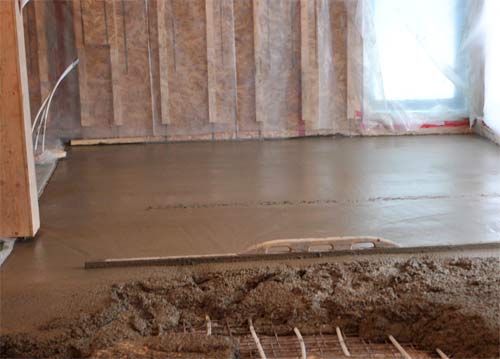Environmentally-friendly materials: the right and affordable choice
CONCRETE: A VERY SUSTAINABLE MATERIAL
Concrete, composed of cement, water and aggregates, is the most used construction material in the world. Why? For its cost/efficiency ratio and its high sustainability. However, its ecological footprint is very large. For each tonne of cement produced, one tonne of greenhouse gas escapes into the atmosphere. That’s a lot!
 A home built on a slab-on-grade, instead of a basement foundation, means that the concrete, previously unsustainable, now becomes a very attractive material to work with: it is versatile, it plays a structural role (foundation of the house) and acts as a finishing material (floor coverings). In addition, it is recyclable, very durable, does not release VOCs and provides an excellent thermal mass. Concrete is locally available, has no negative effects on health, easy to maintain and will almost always be able to be upgraded.
A home built on a slab-on-grade, instead of a basement foundation, means that the concrete, previously unsustainable, now becomes a very attractive material to work with: it is versatile, it plays a structural role (foundation of the house) and acts as a finishing material (floor coverings). In addition, it is recyclable, very durable, does not release VOCs and provides an excellent thermal mass. Concrete is locally available, has no negative effects on health, easy to maintain and will almost always be able to be upgraded.
For the ERE 132 home, a local “green” concrete has been used. The concrete we used for the Eco Home is sustainable because we replaced a percentage of the Portland cement composition - the most energy-intensive part of the concrete - with a post-factory cement additive. Thus, from 20% (foundation) to 30% (slab-on-grade) of the Portland cement has been substituted with fly ash1. It is also possible to use glass powder, coming from the collective selection of wine bottles, as a substitute. In both cases, there is a huge reduction of GHG emissions by using concrete with recycled content, as compared to conventional concrete, for a similar cost and better performance.
1 - Fly ash is a fine residue resulting from the combustion of coal. Inserted in the concrete, it requires a little longer setting time, but contributes to increasing the concrete’s durability.

